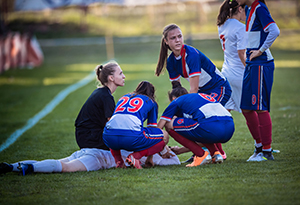The health library is currently experiencing some technical difficulties. We are working to resolve the issues now and apologize for the inconvenience.
Watching for Internal Sports Injury in a Child
Millions of children and teens in the U.S. take part in all kinds of sports. These activities have important physical and social benefits, but they also have some risks. The CDC says that about 2.7 million young people are treated in the emergency room every year for sports injuries.
If you're the parent of a young athlete, you're probably used to dealing with scrapes, bumps, sprains, and strains. Less common but sometimes much more dangerous are internal abdominal injuries from blunt force. These are serious injuries that occur when the body hits or collides with a large object. These types of injuries are most common in contact sports like:
-
Football
-
Ice hockey
-
Soccer
-
Lacrosse
An internal abdominal injury can cause rapid blood loss, so it's important to recognize it as soon as possible. If you or the team coach, healthcare provider, or trainer suspects this type of injury, your child should be taken to an emergency care facility right away.

Types of internal abdominal injury
Sports abdominal injuries are rare, but some studies suggest they are increasing. The most common injuries include:
-
Kidney injury. This may cause flank pain and blood in the urine.
-
Spleen injury. This causes pain in the upper left side of the abdomen. The spleen filters almost 10% of the body's blood supply every minute. Tearing of the spleen can cause rapid and life-threatening internal bleeding.
-
Liver injury. This causes pain in the upper right side of the abdomen. The liver has two lobes. The lobe most often injured is the right lobe. This is because it is bigger and presses against the ribcage. A torn liver can cause severe bleeding.
-
Abdominal injury. This means an injury to the pancreas, diaphragm, stomach, gallbladder, bladder, or intestines. Any organ in the abdomen can be injured. A single organ or multiple organs can be injured.
Signs of internal abdominal injury
These are signs and symptoms to look for:
-
Abdominal pain
-
Tenderness over the injured area
-
Rigid abdomen
-
Left arm and shoulder pain (spleen)
-
Right-sided abdominal pain and right shoulder pain (liver)
-
Blood in the urine (kidney)
-
Cold, sweaty skin (early signs of shock)
-
Bluish discoloration of the belly or bruising particularly around the belly button and flanks
-
Nausea and vomiting
-
Rapid pulse
-
Low blood pressure
-
Loss of consciousness
Diagnosis and treatment of internal abdominal injury
The emergency healthcare team will check your child's pulse and blood pressure. A rapid pulse and falling blood pressure means there is internal bleeding.
This is what may happen next:
-
If your child has internal bleeding, an IV (intravenous) line is placed in their vein. Fluids are given through the IV to stabilize the blood pressure.
-
Blood tests may be done. These are to measure blood volume and to prepare for a blood transfusion if needed. They may also check for abnormal liver enzymes. This is to see if the liver is injured.
-
If blood pressure can't be stabilized, your child will be taken to the operating room. A surgeon will repair the causes of any internal bleeding.
-
If blood pressure is stabilized, a CT scan with contrast may be done. This is to search for any internal damage. Contrast is a special type of dye that is injected into the bloodstream. It makes the CT scan's images easier to read.
-
If there is any blood in your child's urine, a special type of CT scan may be done. This includes putting contrast dye into the bladder and kidneys.
-
If any of the CT scans show a lot of internal bleeding, your child will likely have surgery as soon as possible. If the CT scan shows less severe bleeding, especially in the spleen and liver, your child will be watched very closely. The healthcare team will work to try to treat your child without surgery.
-
If there is no evidence of bleeding, your child may be watched or sent home.
Preventing internal abdominal injury
An internal abdominal sports injury is rare but can be serious. If your child plays a contact sport, take some safety steps:
-
Make sure that the sport is correctly coached and supervised.
-
Make sure a certified athletic trainer is on hand to assess any injuries. They should have an emergency plan in case of a severe abdominal injury or other serious problem.
-
Make sure your child wears protective gear. The gear should meet all safety standards. It should be worn at all times during play.